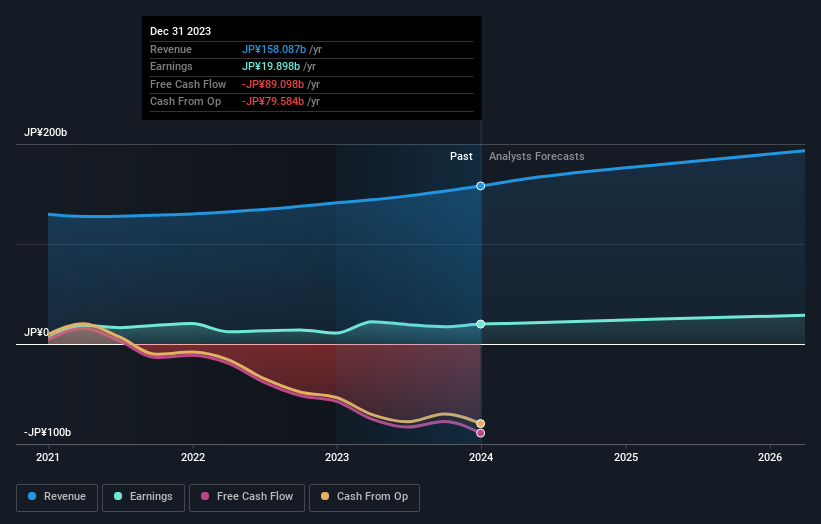Stock Analysis
- Japan
- /
- Consumer Finance
- /
- TSE:8515
Aiful Corporation's (TSE:8515) last week's 3.7% decline must have disappointed individual investors who have a significant stake

Key Insights
- Aiful's significant individual investors ownership suggests that the key decisions are influenced by shareholders from the larger public
- A total of 8 investors have a majority stake in the company with 51% ownership
- 14% of Aiful is held by insiders
If you want to know who really controls Aiful Corporation (TSE:8515), then you'll have to look at the makeup of its share registry. With 45% stake, individual investors possess the maximum shares in the company. Put another way, the group faces the maximum upside potential (or downside risk).
As market cap fell to JP¥215b last week, individual investors would have faced the highest losses than any other shareholder groups of the company.
In the chart below, we zoom in on the different ownership groups of Aiful.
View our latest analysis for Aiful

What Does The Institutional Ownership Tell Us About Aiful?
Institutional investors commonly compare their own returns to the returns of a commonly followed index. So they generally do consider buying larger companies that are included in the relevant benchmark index.
Aiful already has institutions on the share registry. Indeed, they own a respectable stake in the company. This implies the analysts working for those institutions have looked at the stock and they like it. But just like anyone else, they could be wrong. If multiple institutions change their view on a stock at the same time, you could see the share price drop fast. It's therefore worth looking at Aiful's earnings history below. Of course, the future is what really matters.

Hedge funds don't have many shares in Aiful. Looking at our data, we can see that the largest shareholder is AMG Co., Ltd. with 20% of shares outstanding. For context, the second largest shareholder holds about 13% of the shares outstanding, followed by an ownership of 6.9% by the third-largest shareholder. Mitsuhide Fukuda, who is the second-largest shareholder, also happens to hold the title of Chief Executive Officer.
We did some more digging and found that 8 of the top shareholders account for roughly 51% of the register, implying that along with larger shareholders, there are a few smaller shareholders, thereby balancing out each others interests somewhat.
While it makes sense to study institutional ownership data for a company, it also makes sense to study analyst sentiments to know which way the wind is blowing. Quite a few analysts cover the stock, so you could look into forecast growth quite easily.
Insider Ownership Of Aiful
While the precise definition of an insider can be subjective, almost everyone considers board members to be insiders. Management ultimately answers to the board. However, it is not uncommon for managers to be executive board members, especially if they are a founder or the CEO.
Insider ownership is positive when it signals leadership are thinking like the true owners of the company. However, high insider ownership can also give immense power to a small group within the company. This can be negative in some circumstances.
It seems insiders own a significant proportion of Aiful Corporation. It is very interesting to see that insiders have a meaningful JP¥29b stake in this JP¥215b business. It is good to see this level of investment. You can check here to see if those insiders have been buying recently.
General Public Ownership
With a 45% ownership, the general public, mostly comprising of individual investors, have some degree of sway over Aiful. While this group can't necessarily call the shots, it can certainly have a real influence on how the company is run.
Private Company Ownership
It seems that Private Companies own 25%, of the Aiful stock. It might be worth looking deeper into this. If related parties, such as insiders, have an interest in one of these private companies, that should be disclosed in the annual report. Private companies may also have a strategic interest in the company.
Next Steps:
It's always worth thinking about the different groups who own shares in a company. But to understand Aiful better, we need to consider many other factors. Case in point: We've spotted 1 warning sign for Aiful you should be aware of.
If you would prefer discover what analysts are predicting in terms of future growth, do not miss this free report on analyst forecasts.
NB: Figures in this article are calculated using data from the last twelve months, which refer to the 12-month period ending on the last date of the month the financial statement is dated. This may not be consistent with full year annual report figures.
Valuation is complex, but we're helping make it simple.
Find out whether Aiful is potentially over or undervalued by checking out our comprehensive analysis, which includes fair value estimates, risks and warnings, dividends, insider transactions and financial health.
View the Free AnalysisHave feedback on this article? Concerned about the content? Get in touch with us directly. Alternatively, email editorial-team (at) simplywallst.com.
This article by Simply Wall St is general in nature. We provide commentary based on historical data and analyst forecasts only using an unbiased methodology and our articles are not intended to be financial advice. It does not constitute a recommendation to buy or sell any stock, and does not take account of your objectives, or your financial situation. We aim to bring you long-term focused analysis driven by fundamental data. Note that our analysis may not factor in the latest price-sensitive company announcements or qualitative material. Simply Wall St has no position in any stocks mentioned.
About TSE:8515
Aiful
Engages in the consumer finance and credit guarantee business in Japan.
Very undervalued with moderate growth potential.


